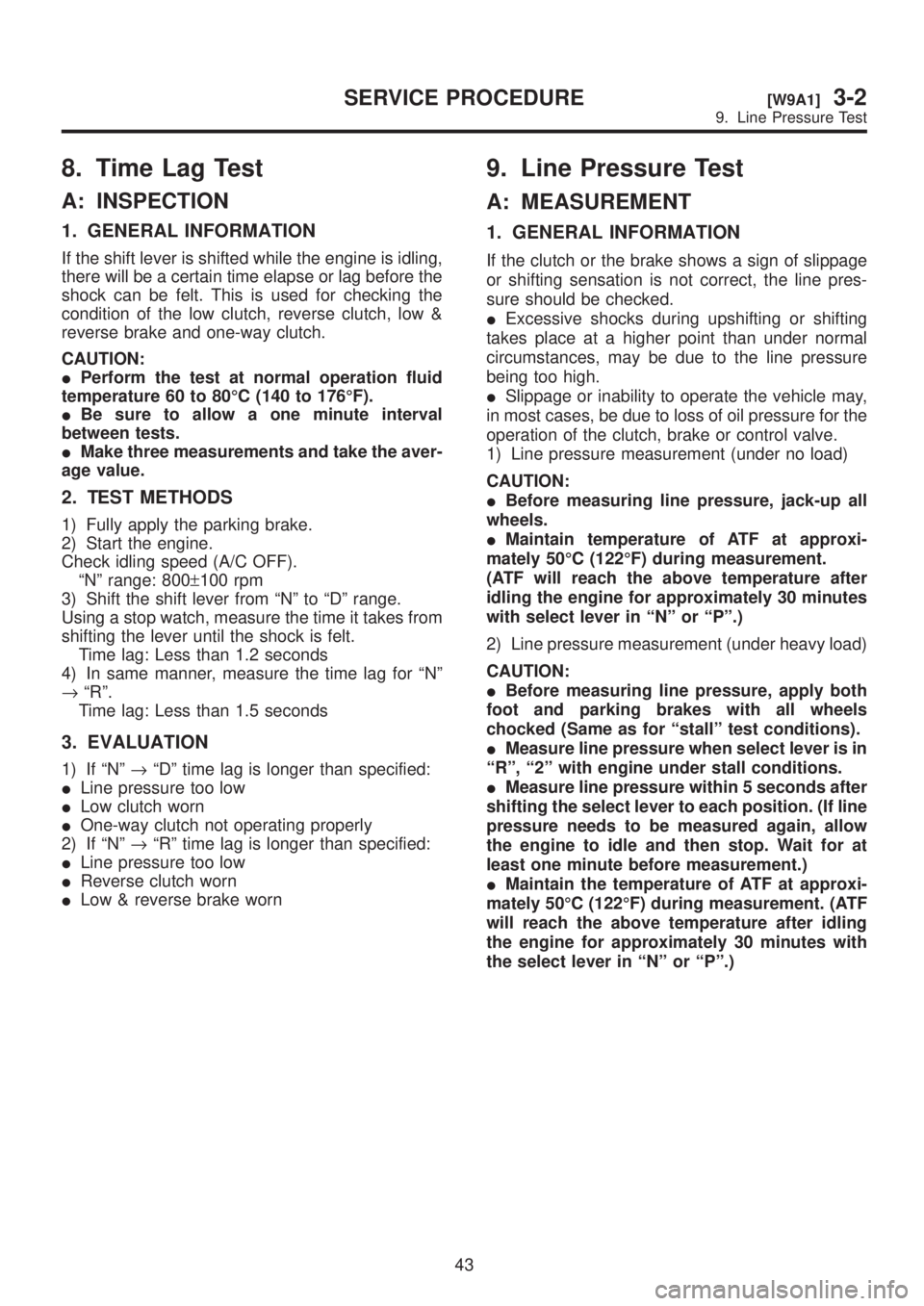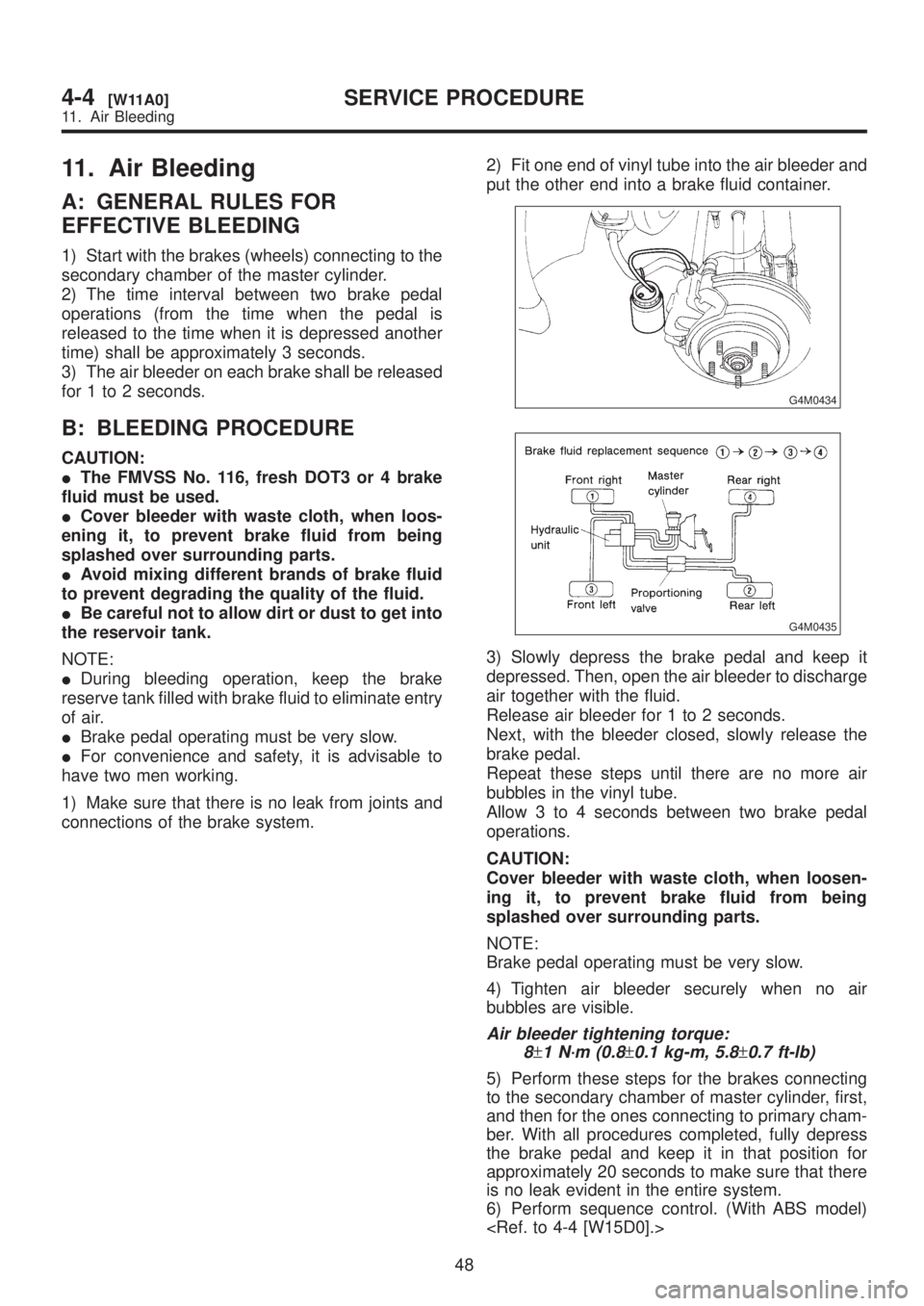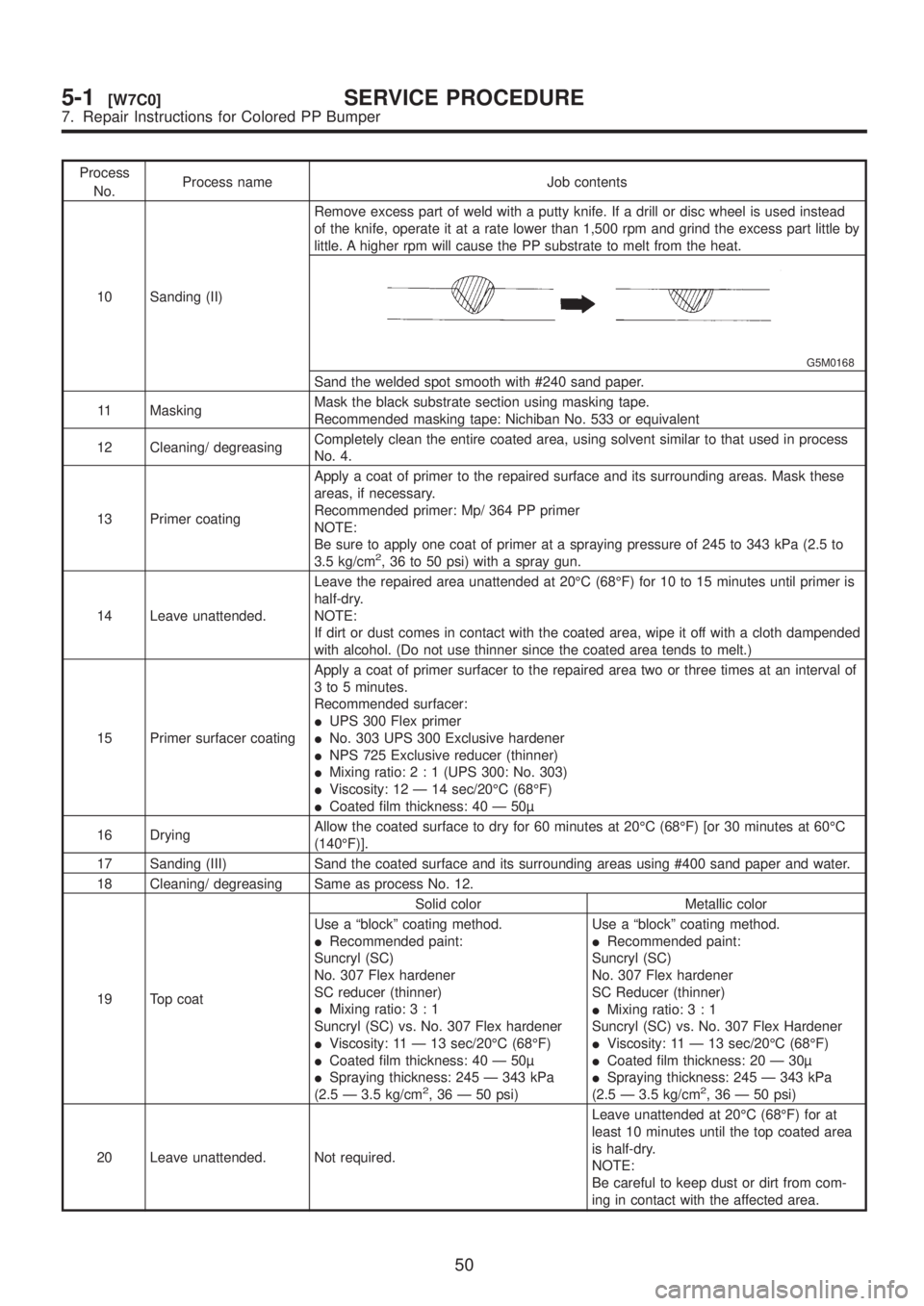1999 SUBARU LEGACY service interval
[x] Cancel search: service intervalPage 383 of 1456
![SUBARU LEGACY 1999 Service Repair Manual 4. Fuel Filter
A: REMOVAL
1) Release fuel pressure. <Ref. to 2-8 [W1B0].>
2) Disconnect fuel delivery hoses from fuel filter.
S2M0195
3) Remove filter from holder.
B: INSPECTION
1) Check the inside of SUBARU LEGACY 1999 Service Repair Manual 4. Fuel Filter
A: REMOVAL
1) Release fuel pressure. <Ref. to 2-8 [W1B0].>
2) Disconnect fuel delivery hoses from fuel filter.
S2M0195
3) Remove filter from holder.
B: INSPECTION
1) Check the inside of](/manual-img/17/57435/w960_57435-382.png)
4. Fuel Filter
A: REMOVAL
1) Release fuel pressure.
2) Disconnect fuel delivery hoses from fuel filter.
S2M0195
3) Remove filter from holder.
B: INSPECTION
1) Check the inside of fuel filter for dirt and water
sediment.
2) If it is clogged, or if replacement interval has
been reached, replace it.
3) If water is found in it, shake and expel the water
from inlet port.
C: INSTALLATION
CAUTION:
IIf fuel hoses are damaged at the connecting
portion, replace it with a new one.
IIf clamps are badly damaged, replace with
new ones.
1) Installation is in the reverse order of removal.
2) Tighten hose clamp screws.
Tightening torque:
1.0+0.5/þ0N´m (0.1+0.05/þ0kg-m, 0.7+0.4/þ0ft-lb)
S2M0195
5. Fuel Pump
A: REMOVAL
1) Release fuel pressure.
2) Disconnect fuel delivery hose (A), return hose
(B) and jet pump hose (C) (AWD model only).
B2M0048B
3) Remove nuts which install fuel pump assembly
onto fuel tank.
G2M0343
4) Take off fuel pump from fuel tank.
G2M0344
21
[W5A0]2-8SERVICE PROCEDURE
5. Fuel Pump
Page 384 of 1456
![SUBARU LEGACY 1999 Service Repair Manual 4. Fuel Filter
A: REMOVAL
1) Release fuel pressure. <Ref. to 2-8 [W1B0].>
2) Disconnect fuel delivery hoses from fuel filter.
S2M0195
3) Remove filter from holder.
B: INSPECTION
1) Check the inside of SUBARU LEGACY 1999 Service Repair Manual 4. Fuel Filter
A: REMOVAL
1) Release fuel pressure. <Ref. to 2-8 [W1B0].>
2) Disconnect fuel delivery hoses from fuel filter.
S2M0195
3) Remove filter from holder.
B: INSPECTION
1) Check the inside of](/manual-img/17/57435/w960_57435-383.png)
4. Fuel Filter
A: REMOVAL
1) Release fuel pressure.
2) Disconnect fuel delivery hoses from fuel filter.
S2M0195
3) Remove filter from holder.
B: INSPECTION
1) Check the inside of fuel filter for dirt and water
sediment.
2) If it is clogged, or if replacement interval has
been reached, replace it.
3) If water is found in it, shake and expel the water
from inlet port.
C: INSTALLATION
CAUTION:
IIf fuel hoses are damaged at the connecting
portion, replace it with a new one.
IIf clamps are badly damaged, replace with
new ones.
1) Installation is in the reverse order of removal.
2) Tighten hose clamp screws.
Tightening torque:
1.0+0.5/þ0N´m (0.1+0.05/þ0kg-m, 0.7+0.4/þ0ft-lb)
S2M0195
5. Fuel Pump
A: REMOVAL
1) Release fuel pressure.
2) Disconnect fuel delivery hose (A), return hose
(B) and jet pump hose (C) (AWD model only).
B2M0048B
3) Remove nuts which install fuel pump assembly
onto fuel tank.
G2M0343
4) Take off fuel pump from fuel tank.
G2M0344
21
[W5A0]2-8SERVICE PROCEDURE
5. Fuel Pump
Page 571 of 1456

8. Time Lag Test
A: INSPECTION
1. GENERAL INFORMATION
If the shift lever is shifted while the engine is idling,
there will be a certain time elapse or lag before the
shock can be felt. This is used for checking the
condition of the low clutch, reverse clutch, low &
reverse brake and one-way clutch.
CAUTION:
IPerform the test at normal operation fluid
temperature 60 to 80ÉC (140 to 176ÉF).
IBe sure to allow a one minute interval
between tests.
IMake three measurements and take the aver-
age value.
2. TEST METHODS
1) Fully apply the parking brake.
2) Start the engine.
Check idling speed (A/C OFF).
ªNº range: 800±100 rpm
3) Shift the shift lever from ªNº to ªDº range.
Using a stop watch, measure the time it takes from
shifting the lever until the shock is felt.
Time lag: Less than 1.2 seconds
4) In same manner, measure the time lag for ªNº
®ªRº.
Time lag: Less than 1.5 seconds
3. EVALUATION
1) If ªNº®ªDº time lag is longer than specified:
ILine pressure too low
ILow clutch worn
IOne-way clutch not operating properly
2) If ªNº®ªRº time lag is longer than specified:
ILine pressure too low
IReverse clutch worn
ILow & reverse brake worn
9. Line Pressure Test
A: MEASUREMENT
1. GENERAL INFORMATION
If the clutch or the brake shows a sign of slippage
or shifting sensation is not correct, the line pres-
sure should be checked.
IExcessive shocks during upshifting or shifting
takes place at a higher point than under normal
circumstances, may be due to the line pressure
being too high.
ISlippage or inability to operate the vehicle may,
in most cases, be due to loss of oil pressure for the
operation of the clutch, brake or control valve.
1) Line pressure measurement (under no load)
CAUTION:
IBefore measuring line pressure, jack-up all
wheels.
IMaintain temperature of ATF at approxi-
mately 50ÉC (122ÉF) during measurement.
(ATF will reach the above temperature after
idling the engine for approximately 30 minutes
with select lever in ªNº or ªPº.)
2) Line pressure measurement (under heavy load)
CAUTION:
IBefore measuring line pressure, apply both
foot and parking brakes with all wheels
chocked (Same as for ªstallº test conditions).
IMeasure line pressure when select lever is in
ªRº, ª2º with engine under stall conditions.
IMeasure line pressure within 5 seconds after
shifting the select lever to each position. (If line
pressure needs to be measured again, allow
the engine to idle and then stop. Wait for at
least one minute before measurement.)
IMaintain the temperature of ATF at approxi-
mately 50ÉC (122ÉF) during measurement. (ATF
will reach the above temperature after idling
the engine for approximately 30 minutes with
the select lever in ªNº or ªPº.)
43
[W9A1]3-2SERVICE PROCEDURE
9. Line Pressure Test
Page 572 of 1456

8. Time Lag Test
A: INSPECTION
1. GENERAL INFORMATION
If the shift lever is shifted while the engine is idling,
there will be a certain time elapse or lag before the
shock can be felt. This is used for checking the
condition of the low clutch, reverse clutch, low &
reverse brake and one-way clutch.
CAUTION:
IPerform the test at normal operation fluid
temperature 60 to 80ÉC (140 to 176ÉF).
IBe sure to allow a one minute interval
between tests.
IMake three measurements and take the aver-
age value.
2. TEST METHODS
1) Fully apply the parking brake.
2) Start the engine.
Check idling speed (A/C OFF).
ªNº range: 800±100 rpm
3) Shift the shift lever from ªNº to ªDº range.
Using a stop watch, measure the time it takes from
shifting the lever until the shock is felt.
Time lag: Less than 1.2 seconds
4) In same manner, measure the time lag for ªNº
®ªRº.
Time lag: Less than 1.5 seconds
3. EVALUATION
1) If ªNº®ªDº time lag is longer than specified:
ILine pressure too low
ILow clutch worn
IOne-way clutch not operating properly
2) If ªNº®ªRº time lag is longer than specified:
ILine pressure too low
IReverse clutch worn
ILow & reverse brake worn
9. Line Pressure Test
A: MEASUREMENT
1. GENERAL INFORMATION
If the clutch or the brake shows a sign of slippage
or shifting sensation is not correct, the line pres-
sure should be checked.
IExcessive shocks during upshifting or shifting
takes place at a higher point than under normal
circumstances, may be due to the line pressure
being too high.
ISlippage or inability to operate the vehicle may,
in most cases, be due to loss of oil pressure for the
operation of the clutch, brake or control valve.
1) Line pressure measurement (under no load)
CAUTION:
IBefore measuring line pressure, jack-up all
wheels.
IMaintain temperature of ATF at approxi-
mately 50ÉC (122ÉF) during measurement.
(ATF will reach the above temperature after
idling the engine for approximately 30 minutes
with select lever in ªNº or ªPº.)
2) Line pressure measurement (under heavy load)
CAUTION:
IBefore measuring line pressure, apply both
foot and parking brakes with all wheels
chocked (Same as for ªstallº test conditions).
IMeasure line pressure when select lever is in
ªRº, ª2º with engine under stall conditions.
IMeasure line pressure within 5 seconds after
shifting the select lever to each position. (If line
pressure needs to be measured again, allow
the engine to idle and then stop. Wait for at
least one minute before measurement.)
IMaintain the temperature of ATF at approxi-
mately 50ÉC (122ÉF) during measurement. (ATF
will reach the above temperature after idling
the engine for approximately 30 minutes with
the select lever in ªNº or ªPº.)
43
[W9A1]3-2SERVICE PROCEDURE
9. Line Pressure Test
Page 924 of 1456

11. Air Bleeding
A: GENERAL RULES FOR
EFFECTIVE BLEEDING
1) Start with the brakes (wheels) connecting to the
secondary chamber of the master cylinder.
2) The time interval between two brake pedal
operations (from the time when the pedal is
released to the time when it is depressed another
time) shall be approximately 3 seconds.
3) The air bleeder on each brake shall be released
for 1 to 2 seconds.
B: BLEEDING PROCEDURE
CAUTION:
IThe FMVSS No. 116, fresh DOT3 or 4 brake
fluid must be used.
ICover bleeder with waste cloth, when loos-
ening it, to prevent brake fluid from being
splashed over surrounding parts.
IAvoid mixing different brands of brake fluid
to prevent degrading the quality of the fluid.
IBe careful not to allow dirt or dust to get into
the reservoir tank.
NOTE:
IDuring bleeding operation, keep the brake
reserve tank filled with brake fluid to eliminate entry
of air.
IBrake pedal operating must be very slow.
IFor convenience and safety, it is advisable to
have two men working.
1) Make sure that there is no leak from joints and
connections of the brake system.2) Fit one end of vinyl tube into the air bleeder and
put the other end into a brake fluid container.
G4M0434
G4M0435
3) Slowly depress the brake pedal and keep it
depressed. Then, open the air bleeder to discharge
air together with the fluid.
Release air bleeder for 1 to 2 seconds.
Next, with the bleeder closed, slowly release the
brake pedal.
Repeat these steps until there are no more air
bubbles in the vinyl tube.
Allow 3 to 4 seconds between two brake pedal
operations.
CAUTION:
Cover bleeder with waste cloth, when loosen-
ing it, to prevent brake fluid from being
splashed over surrounding parts.
NOTE:
Brake pedal operating must be very slow.
4) Tighten air bleeder securely when no air
bubbles are visible.
Air bleeder tightening torque:
8
±1 N´m (0.8±0.1 kg-m, 5.8±0.7 ft-lb)
5) Perform these steps for the brakes connecting
to the secondary chamber of master cylinder, first,
and then for the ones connecting to primary cham-
ber. With all procedures completed, fully depress
the brake pedal and keep it in that position for
approximately 20 seconds to make sure that there
is no leak evident in the entire system.
6) Perform sequence control. (With ABS model)
48
4-4[W11A0]SERVICE PROCEDURE
11. Air Bleeding
Page 1071 of 1456

6. Coating Method for PP Bumper
A: PROCESS STEPS
Process
No.Process name Job contents
1 Bumper mountingSet bumper on paint work table if required.
Use paint work table conforming to inner
shape of bumper when possible.
G5M0164
2 MaskingMask specified part (black base) with masking tape. Use masking tape for PP (e.g.,
Nichiban No. 533, etc.).
3 Degreasing, cleaningClean all parts to be painted with white gasoline, normal alcohol, etc. to remove dirt,
oil, fat, etc.
4 Primer paintFirst, apply one coat of primer to all parts to be painted, using air gun. Use primer
(clear).
5 DryingDry at normal temperature [10 to 15 min. at 20ÉC (68ÉF)].
In half-dried condition, PP primer paint is dissolved by solvent, e.g. thinner, etc.
Therefore, if dust or dirt must be removed, use ordinary alcohol, etc.
6 Top coat paint (I)Solid color Metallic color
Use section (block) paint for top coat.
IPaint in use (for each color):
Solid paint
Hardener PB
Thinner T-301
IMixing ratio:
Main agent vs. hardener = 4:1
IViscosity: 10 Ð 13 sec/20ÉC (68ÉF)
IFilm thickness: 35 Ð 45
ISpraying pressure: 245 Ð 343 kPa (2.5
Ð 3.5 kg/cm
2, 36 Ð 50 psi)Use section (block) paint for top coat.
IPaint in use (for each color):
Metallic paint
Hardener PB
Thinner T-306
IMixing ratio:
Main agent vs. hardener = 10:1
IViscosity: 10 Ð 13 sec/20ÉC (68ÉF)
IFilm thickness: 15 Ð 20
ISpraying pressure: 245 Ð 343 kPa (2.5
Ð 3.5 kg/cm2, 36 Ð 50 psi)
7 Drying Not required.Dry at normal temperature [10 min. or
more at 20ÉC (68ÉF)].
In half-dried condition, avoid dust, dirt.
8 Top coat paint (II) Not required.Apply a clear coat to parts with top coat
paint (I), three times, at5Ð7minutes
intervals.
IPaint in use:
Metallic paint
Hardener PB
Thinner T-301
IMixing ratio: Clear vs. hardener = 6:1
IViscosity: 14 Ð 16 sec/20ÉC (68ÉF)
IFilm thickness: 25 Ð 30
ISpraying pressure: 245 Ð 343 kPa (2.5
Ð 3.5 kg/cm
2, 36 Ð 50 psi)
9 Drying60ÉC (140ÉF), 60 min. or 80ÉC (176ÉF), 30 min.
If higher than 80ÉC (176ÉF), PP may be deformed. Keep maximum temperature of
80ÉC (176ÉF).
10 Inspection Paint check
11 Masking removal Remove masking in process No. 2.
47
[W6A0]5-1SERVICE PROCEDURE
6. Coating Method for PP Bumper
Page 1074 of 1456

Process
No.Process name Job contents
10 Sanding (II)Remove excess part of weld with a putty knife. If a drill or disc wheel is used instead
of the knife, operate it at a rate lower than 1,500 rpm and grind the excess part little by
little. A higher rpm will cause the PP substrate to melt from the heat.
G5M0168
Sand the welded spot smooth with #240 sand paper.
11 MaskingMask the black substrate section using masking tape.
Recommended masking tape: Nichiban No. 533 or equivalent
12 Cleaning/ degreasingCompletely clean the entire coated area, using solvent similar to that used in process
No. 4.
13 Primer coatingApply a coat of primer to the repaired surface and its surrounding areas. Mask these
areas, if necessary.
Recommended primer: Mp/ 364 PP primer
NOTE:
Be sure to apply one coat of primer at a spraying pressure of 245 to 343 kPa (2.5 to
3.5 kg/cm
2, 36 to 50 psi) with a spray gun.
14 Leave unattended.Leave the repaired area unattended at 20ÉC (68ÉF) for 10 to 15 minutes until primer is
half-dry.
NOTE:
If dirt or dust comes in contact with the coated area, wipe it off with a cloth dampended
with alcohol. (Do not use thinner since the coated area tends to melt.)
15 Primer surfacer coatingApply a coat of primer surfacer to the repaired area two or three times at an interval of
3 to 5 minutes.
Recommended surfacer:
IUPS 300 Flex primer
INo. 303 UPS 300 Exclusive hardener
INPS 725 Exclusive reducer (thinner)
IMixing ratio:2:1(UPS 300: No. 303)
IViscosity: 12 Ð 14 sec/20ÉC (68ÉF)
ICoated film thickness: 40 Ð 50
16 DryingAllow the coated surface to dry for 60 minutes at 20ÉC (68ÉF) [or 30 minutes at 60ÉC
(140ÉF)].
17 Sanding (III) Sand the coated surface and its surrounding areas using #400 sand paper and water.
18 Cleaning/ degreasing Same as process No. 12.
19 Top coatSolid color Metallic color
Use a ªblockº coating method.
IRecommended paint:
Suncryl (SC)
No. 307 Flex hardener
SC reducer (thinner)
IMixing ratio:3:1
Suncryl (SC) vs. No. 307 Flex hardener
IViscosity: 11 Ð 13 sec/20ÉC (68ÉF)
ICoated film thickness: 40 Ð 50
ISpraying thickness: 245 Ð 343 kPa
(2.5 Ð 3.5 kg/cm
2, 36 Ð 50 psi)Use a ªblockº coating method.
IRecommended paint:
Suncryl (SC)
No. 307 Flex hardener
SC Reducer (thinner)
IMixing ratio:3:1
Suncryl (SC) vs. No. 307 Flex Hardener
IViscosity: 11 Ð 13 sec/20ÉC (68ÉF)
ICoated film thickness: 20 Ð 30
ISpraying thickness: 245 Ð 343 kPa
(2.5 Ð 3.5 kg/cm2, 36 Ð 50 psi)
20 Leave unattended. Not required.Leave unattended at 20ÉC (68ÉF) for at
least 10 minutes until the top coated area
is half-dry.
NOTE:
Be careful to keep dust or dirt from com-
ing in contact with the affected area.
50
5-1[W7C0]SERVICE PROCEDURE
7. Repair Instructions for Colored PP Bumper